|
"In almost every
part of or world the owl has held a fascination for mankind at one time
or another. Sometimes the bird has been worshipped as a lofty oracle.
Other times its eerie cries and staring eyes have made it feared as an
evil sorcerer."--------1967,
Faith Medlin, "Centuries Of Owls, In Art And The Written Word." p. 13.
"As
nocturnal predators, owls are linked with the feminine, night, the moon,
death, magic, and dreams."----2006,
Hope B. Werness, "The Continuum, Encyclopedia Of Animal Symbolism
In Art," p. 303.
"The bones of snowy owls have been found in
various caves (in France), and more than 1,100 bones from more than eighty large
owls have been found in association with Paleolithic tools."---------2008,
Darryl Wheye & Donald Kennedy, "Humans, Nature, And Birds, Science Art
From Cave Walls To Computer Screens," p. 24.
"---Paleolithic bird images were not as widely
produced (in French cave sites)
as the megafauna were---."------2008,
Darryl Wheye & Donald Kennedy, "Humans, Nature, And Birds, Science Art
From Cave Walls To Computer Screens," p. 2.
"----2006,
Vance T. Holliday & Rolfe D. Mandel, "Geoarcheology Of The Plains,
Southwest, And Great Lakes," Handbook Of North American Indians,
Vol. 4 Environment, Origins, and Population (Smithsonian), p. 30.
"A
man became a shaman from the moment he received a soul in his body.
Chebero (who live on the tributaries of the
upper Amazon River) medicine men were
trained in their art by an owl."----1949,
Alfred Metraux, "Religion And Shamanism," Handbook Of South American Indians,
Vol. 5, The Comparative Ethnology Of South American Indians (Smithsonian),
p. 591.
"Vapor inhalants
are employed in some respiratory ailments (among
the Aymara of Peru & Bolivia) and
burning owl feathers are used to cure earache."----1946,
Harry Tschopik, Jr., "The Aymara," Handbook Of South American Indians,
Vol. 2, The Andean Civilizations (Smithsonian) p. 569.
"---(among
the Yahgan of the southern Andean Mountains)
the call of the owl was supposed to portend a murder or at least a death."----1946,
John M. Cooper, "The Yahgan," Handbook Of South American Indians,
Vol. 1, The Marginal Tribes (Smithsonian) p. 102.
"To some of the
river plains tribes (in the central South
American continent), certain birds
say, "Danger! White people are near." Another bird sings, "The brethren
are coming!" And the big owl says, "Beware" I am bringing spirits to
harm you."----1946,
Juan Belaieff, "The Present-Day Indians Of The Gran Chaco,"
Handbook Of South American Indians,
Vol. 1, The Marginal Tribes (Smithsonian) p. 380.
"Among
the Sioux, Hin-Han the owl guards the entrance to the Milky Way over
which the souls of the dead must pass to reach the spirit land. Those
who fail the owl's inspection because they do not have the proper tattoo
on their wrists or elsewhere is thrown into the bottomless abyss.
On-the-other-hand, among some nations, the owl is a wise and friendly
spirit and advisor and warning giver."--------1984,
Richard Erdoes, & Alfonso Ortiz, "American Indian Myths And Legends," p.
400.

PREHISTORIC OWL IMAGERY & MYTH
WORLDWIDE
35,000 YEARS AGO TO RECENT
PAST
People have been creating images and mythic
stories about owls for tens of thousands of years. They have been
portrayed in every imaginable form on
everything from cave walls to small portable objects. The mystical
energy they project most certainly comes from their power of acute vision, silent
flight, powerful claws, and, most importantly, they are creatures of the
night. |
|
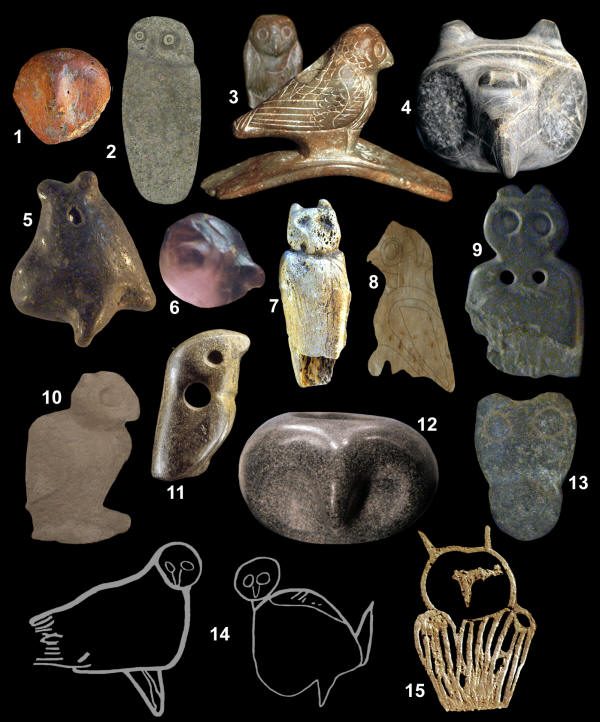
CLICK ON PICTURE FOR LARGER IMAGE
OWL IMAGES IN STONE,
BONE, AND CLAY
ILLINOIS, MISSOURI, OHIO,
MISSISSIPPI, COSTA RICA & FRANCE
This assortment of prehistoric owl
figures illustrate how diverse a design style can be and still
project a fairly strong owl image in the mind of the observer. The
images range from a simple slightly altered pebble to very natural
full body sculptures.
1.
This small clay head is reported to have been found on the Cahokia
Mounds site. Although it has no eyes, the round shape of the head
and the beak are features that present the image as an owl. The
lower portion of the head is broken away indicating that it was
probably once attached to some type of ceramic vessel. It measures
5/8 inch (1.6 cm) high.
2. This
computerized image shows the basic design pattern of an owl effigy
pipe that was found on a site in northeastern Kentucky. The bowl is
located behind the neck area. It's made from a very fine green-gray
Ohio pipestone and measures approximately 2 1/2 inches (6.4 cm)
long.
3.
This is an exceptionally nice example of an effigy platform pipe from the Knight site in southern
Illinois. It skillfully illustrates the full standing figure of an
owl. The carving of the feet, claws, feathers and features of the head
are all very well done. This pipe was once in the Dr. Titterington
collection and is known as the "Titterington pipe."
4.
A common form of Costa Rican owl effigy mace head. Costa Rican stone
maces are unique for their many different carved forms that
illustrate both the natural and metaphysical world. In Mesoamerica
the owl is connected to the underworld and the abode of the dead but
also to a warrior class. This Costa Rican owl mace may have once
belonged to members of a warrior caste of wealthy individuals. It
was found on a site in the central highlands of Costa Rica. It's made of a granite-like stone and
it measures 2 inches (5.1 cm) high.
5.
This
clay effigy represents a stylized version of a full figured
standing owl. It's main design features are the "horns," beak,
extended tail, legs and side to side perforation. The perforation
indicates it was probably worn as a pendant. Although the form seems
odd, it does represent a design type that has been reported from
sites farther to the east. It was found at Mound 72 on the Cahokia Mounds site in southern
Illinois. It measures approximately 1 3/4 inches (4.5 cm) long.
6.
A small fluorite bead that was found many years ago on the Cahokia
Mounds site in southern Illinois. Owl fluorite beads are rare but
other examples have been reported.
7.
This carved bone owl effigy was found several years ago by Fred
Bollinger in Scott County, Missouri. Although it's not finely carved
and does have some damage at the bottom front where the feet may
have been, it does have enough design features to identify it as an
owl. It has a round head, large eyes, two "horns," and engraved
wings. The deeply grooved neck suggests that it may have been
suspended from the groove. The bone may be identified as deer. It measures 1 11/16 inches (4.3 cm) long.
8.
A computerized likeness of a carved bone owl effigy that was found
with a burial on the Campbell site in southeastern Missouri.
It's described as a, "remarkably well-preserved carved bone owl
effigy pendant that was recovered in association with a child." It
was positioned at the neck of the individual and most probably was
used as a pendant. The bone is drilled at the neck from front to
back and it has nicely carved feet. It was carved from the second
phalanx (toe bone) of an adult deer and measures 1 5/8 inches (4.2
cm) long.
9.
This owl effigy pendant is believed to
have been found on the Cahokia Mounds site in southern Illinois.
The lower portion has broken away, but the main upper portion
is preserved. Although there is no beak, the round shape of the
head, large eyes, and the two "horns" very effectively portray the
image of an owl. The "horns" suggest that it may represent a great
horned owl. The eyes are deeply drilled and may once have contained
some type of inlay material. There are two smaller suspension holes
at the upper chest which may have served to hold the image flat
against the body if it was worn as an ornament suspended from the
neck. This pendant is made of canal coal and it measures 1 1/4
inches (3.2 cm) long.
10.
This pipe was originally in the Claude Stone collection. It's
illustrated in an early issue of the Journal Of The Illinois State
Archaeological Society over a caption saying it's described in
another issue. It's a good example of a stone carved owl with large
eyes and the often represented "horns" on the top of the head.
11.
This picture shows an excellent example of a Poverty Point culture
animal effigy bead. It was found on a Late Archaic site in Louisiana
near the Poverty Point site. This bead was skillfully crafted from
hard stone by pecking, grinding, and polishing into the form of an
owl. The beak, wings, and feet are well represented.
12.
This is a nice example of a Costa Rican owl effigy mace head. Costa Rican stone maces are
unique for their many different carved forms that illustrate both
the natural and metaphysical world. In Mesoamerica the owl is
connected to the underworld and the abode of the dead but also to a
warrior class. This Costa Rican owl mace may have once belonged to
members of a warrior caste of wealthy individuals. It was found on a
site in the central highlands of Costa Rica.
13.
This simple owl effigy pendant is reported to have been found in
Jackson County, Illinois by Don Ethenton on a
multi-component camp site. The site produced both Mississippian and
Woodland artifacts. The main design features are the large eyes and the two "horns."
The "horns" indicate that it probably
represents a great horned owl.
The eyes are very shallow and were formed by hard stone pecking. The
"horns" were formed by notching the top center of the head. The
shape of the head follows the natural shape of the pebble. The
identifying suspension feature is in the form of a fairly deep notch
that encircles the narrow end of the pebble. It appears to have been
suspended in an inverted position. This owl pendant was made on a
small hard-stone pebble and it measures 1 3/8 inches (3.5 cm) long.
14.
These two images are computerized likeness of two engraved owls that
were discovered on a cave wall in southwestern France. The cave site
is known as the Les Trois Freres
(three brothers) cave. A third smaller owl, that is described as a
chick, was also found situated between the two. They are referred to
as snowy owls because they have no feather-horns and the bones of
snowy owls have been found on many early cave sites. These engravings
are believed to date to at least 17,000 years ago.
15. This picture shows a computerized likeness of the oldest image
of an owl. It's actually the only known example of an owl in
Paleolithic art. It was discovered on a Paleolithic site in southern
France called Chauvet cave. The engraving, of what has been identified as a
great horned owl, is situated on an overhanging rock next to the
image of a horse. It's described as "a finger tracing of an owl in the soft outer layer of the cave wall."
One description interprets the image as an owl looking backwards
over its back. This engraved owl dates to sometime between 32,000
and 35,000 years ago. |
|
|
The history of owls are recorded in the fossil record as
early as 60 million years ago. There are over 200 species
of owls living today. Almost everyone on the planet has some type of owl
living in their local environment, except in Antarctica and on some
oceanic islands. In-other-words, owls have been and still are, well
established within earth's natural terrestrial ecosystem. |
|
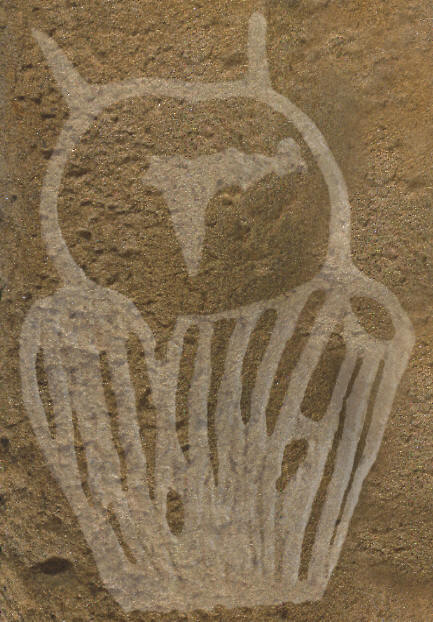
COMPUTERIZED LIKENESS OF ORIGINAL CAVE ENGRAVING
ENGRAVED OWL ON CAVE WALL
CHAUVET CAVE
SOUTHERN FRANCE
32,000 TO 35,000 YEARS AGO
This picture shows a computerized likeness of the oldest image of an
owl. It's actually the only known example of an owl in Paleolithic
art. It was discovered on a Paleolithic site in southern France
called Chauvet cave. The engraving, of what has been identified as a
great horned owl, is situated on an overhanging rock next to the
image of a horse. It's described as "a finger tracing of an owl in the soft outer layer of the cave wall."
One description interprets the image as an owl looking backwards
over its back. This engraved owl dates to sometime between 32,000
and 35,000 years ago. |
|
|
Image recognition
in primitive art is important. The most impressive examples are made
with the least amount of lines, but project a strong and powerful image.
They represent some of the
most difficult style of art to produce. Prehistoric artists left behind an enormous
variety of animal figures for modern art historians to study and
interpret. These early craftsmen were producing this type of art from
the very beginning of art history, during the Upper Paleolithic period,
when simple images of owls begin to appear. |
|

COMPUTERIZED LIKENESS OF ORIGINAL CAVE ENGRAVING
ENGRAVED OWLS ON CAVE WALL
LES TROIS FRERIS (THREE BROTHERS)
CAVE
SOUTHWESTERN FRANCE
est. 17,000 YEARS AGO
This picture shows a computerized likeness
of two engraved owls that were discovered on a cave wall in
southwestern France. The cave site is known as the Les Trois Freres
(three brothers) cave. A third smaller owl, that is described as a
chick, was also found situated between the two. They are referred to
as snowy owls because they have no feather-horns and the bones of
snowy owls have been found on many early cave sites. It's reported
that more than 1,100 bones from more than eighty snowy owls have
been found in association with Paleolithic tools. These engravings
are believed to date to at least 17,000 years ago.
Les Trois Freres cave also has an image of a human with an
owl-shaped head, along with antlers, paws, and a tail. This image
may depict a shaman in a trance ritual. |
|
|
The most important design features that owls have,
that set them apart from other birds, are large round heads, large
forward looking eyes, and a sharp downward curved beak. The "horns" of
great horned owls are also often represented on prehistoric owl art. |
|
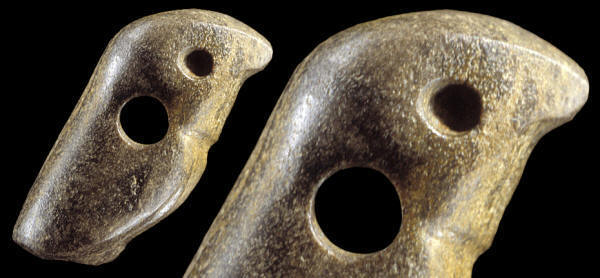
CLICK ON PICTURE FOR LARGER IMAGE
OWL BEAD
POVERTY POINT CULTURE
LATE ARCHAIC
LOUISIANA
est. 3,200 YEARS AGO
This picture shows an excellent example of
a Poverty Point culture animal effigy bead. It was found on a Late
Archaic site in Louisiana near the Poverty Point site. This bead was
skillfully crafted from hard stone by pecking, grinding, and
polishing into the form of an owl. The beak, wings, and feet are
well represented. It dates to sometime around 3,200 years ago.
The Poverty Point culture developed a tradition of making high
quality stylized carved and polished miniature stone beads. Other
early cultures in the United States rarely used stone to make their
beads opting for softer materials such as shell or bone. Poverty
Point craftsmen made many of their beads in the image of animals
that were common to their environment at that time.
Poverty Point is the largest and most complex
Late Archaic site in North America. It was discovered in 1953 by an
archaeologist who discovered the peculiar earthworks on aerial
photographs taken by an Army mapmaker. This site is located in
northeastern Louisiana in West Carroll County. It was in use for
over one thousand years dating to between 3800 and 2500 years ago.
These people produced the largest Archaic Period earthworks ever
built in the United States. |
|
|
The most impressive images of owls are the earliest
examples that were engraved on cave walls in southern France during the
upper Paleolithic period. Most prehistoric owl figures are preserved in
the form of small carved and sculpted portable objects. In the eastern
United States, they were made of hard stone, canal coal, fluorite
crystal, bone, and clay. Many more were probably carved in wood. |
|

OWL EFFIGY PENDANT
CAHOKIA MOUNDS SITE
MADISON/ST. CLAIR COUNTIES, ILLINOIS
This owl effigy pendant is believed
to have been found on the Cahokia Mounds site in southern Illinois.
Although the lower portion has broken away, the main upper portion
is preserved. Although there is no beak, the round shape of the
head, large eyes, and the two "horns" very effectively portray the
image of an owl. The "horns" suggest that it may represent a great
horned owl that have feathered horn-like projections on the top of
their heads. The eyes are deeply drilled and may once have contained
some type of inlay material. There are two smaller suspension holes
at the upper chest which may have served to hold the image flat
against the body if it was worn as an ornament suspended from the
neck. This pendant is made of canal coal and it measures 1 1/4
inches (3.2 cm) long. |
|
|
The earliest depictions of owls appear during the Upper
Paleolithic period, within the Aurignacian cultural tradition. These are
the people who are recognized as the first modern humans in Europe. The
first image of an owl is reported from Chauvet cave in southern France
and dates to sometime between 32,000 and 35,000 years ago. It's
described as "a finger tracing of an owl in the soft outer layer of the
cave wall." The engraving is situated on an overhanging rock next to the
image of a horse. The owl appears to be looking backwards over its back. |
|

OWL EFFIGY PENDANT
JACKSON COUNTY, ILLINOIS
This simple owl effigy pendant is reported
to have been found in Jackson County, Illinois by Don Ethenton on a
multi-component camp site. The site produced both Mississippian and
Woodland artifacts. The main design features are the large eyes and the two "horns."
The "horns" indicate that it probably
represents a great horned owl.
The eyes are very shallow and were formed by hard stone pecking. The
"horns" were formed by notching the top center of the head. The
shape of the head follows the natural shape of the pebble. The
identifying suspension feature is in the form of a fairly deep notch
that encircles the narrow end of the pebble. It appears to have been
suspended in an inverted position. This owl pendant was made on a
small hard-stone pebble and it measures 1 3/8 inches (3.5 cm) long. |
|
|
More recent engravings of owls date to 17,000
years ago and are reported from another Upper Paleolithic cave site in
southwestern France. A group of three
owls were discovered on a cave wall in Les Trois Freres (three
brothers) cave. They are described as two adult and one smaller owl,
that is identified as a chick. The smaller owl is situated between the
two larger owls. They are referred to as snowy owls because they have no
feather-horns and the bones of snowy owls have been found on many early
cave sites. It's reported that more than 1,100 bones from more than
eighty snowy owls have been found in association with Paleolithic tools. |
|
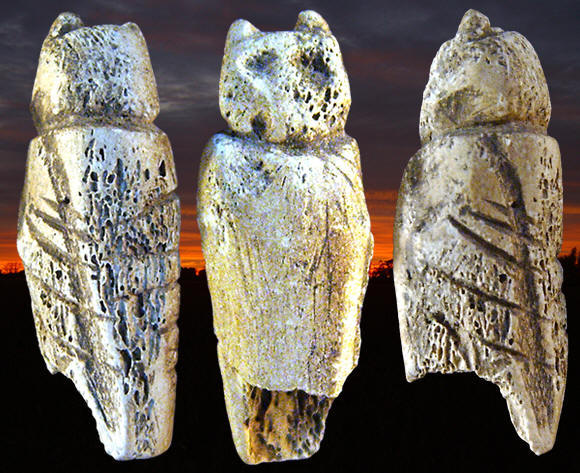
CLICK ON PICTURE FOR LARGER IMAGE
OWL EFFIGY
MISSISSIPPIAN CULTURE
SCOTT COUNTY, MISSOURI
This carved bone owl effigy was found
several years ago by Fred Bollinger in Scott County, Missouri.
Although it's not finely carved and does have some damage at the
bottom front where the feet may have been, it does have enough
features to identify it as an owl. It has a round head, large eyes,
two "horns," and engraved wings. The deeply grooved neck suggests
that it may have been suspended from the groove. This bone carved
owl may have been made from deer bone and it measures 1 11/16 inches
(4.3 cm) long.
Other examples of bone carved owls have been reported from
this same region. A very finely crafted example is reported from a
burial on the Campbell site in Pemiscot County, Missouri. It's
described as a, "remarkably well-preserved carved bone owl effigy
pendant that was recovered in association with a child." It was
positioned at the neck of the individual and most probably was used
as a pendant. The bone is drilled at the neck from front to back and it
has nicely carved feet. It was carved from the second phalanx (toe
bone) of an adult deer and measures 1 5/8 inches (4.2 cm) long.
Another bone carved bird effigy from Arkansas is described as,
"reminiscent of an owl." It was found in a mound in Lafayette
County. Another example is reported from a Middle Mississippian
village site near Memphis, Tennessee and described as a pendant that
was carved from a deer phalange to resemble an owl." Two other owl
bone pendants are reported from separate sites. One example was
found on the little Harpeth River in Williamson County, Tennessee
and the other is a second bone owl found on the Campbell site in
Scott County, Missouri. The Harpeth River bone owl is reported to
have been found in associated with a child burial. |
|
|
In the past and around the world, owls have been seen more as
a negative influence. They have been linked to death, magic, the
underworld, harbingers of disaster, darkness, demons, prophesy, north
wind, witchcraft, drought, a god of death, bird of ill omen and demonic
influences, just to name a few. But on the other hand, they were seen by
the Greeks as wise, by the Aztecs as having a powerful force of
rejuvenation, and by the Australian aborigines as a sacred bird
associated with rain, water and birth. |
|
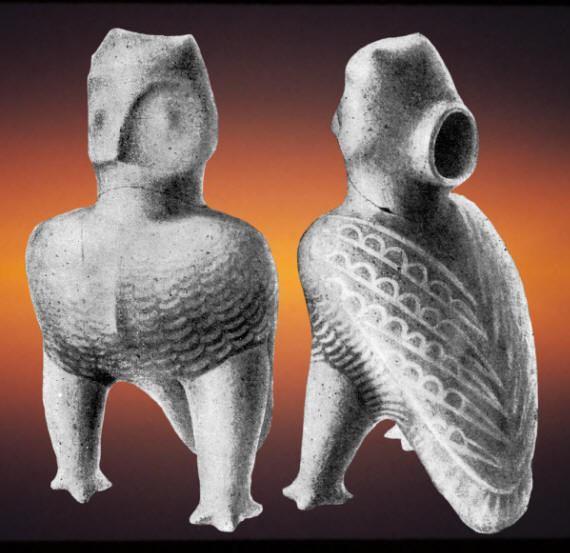
20th Annual Report Of The Bureau Of
American Ethnology, Smithsonian Institution, 1898-1899
PAINTED OWL EFFIGY BOTTLE
TENNESSEE
This ceramic bottle is one of the nicest examples of an owl effigy
that has been found in the Middle Mississippi Valley region. It was
illustrated by Powell in 1903 in an issue of "The Bureau Of American
Ethnology." He reports that it was found in Tennessee and that "The
delineation of the painted specimen "c" is unusually realistic, and
the general appearance recalls very forcibly the painted owl vases
of the Tusayan (Pueblo)
tribes and the more ancient occupants of the valley of the Rio
Colorado." |
|
|
On the topic of rebirth and reincarnation, some
tribal groups have had a belief in human-to-animal, animal-to-human, and
human-to-human transformations. In Amerindian and Inuit Reincarnation
references, Mills reports 279 references of human-to-human and 77
references of humans transforming to animals after death or transforming
from animals to humans at birth. Boas (1896) reported that Kwakiutl (Pacific
northwest coast) land hunters were
thought to return as wolves and that sea hunters returned as killer
whales but that common people returned as owls or ghosts. Devereux
(1961) reported that the Mohave people (Mohave
Desert area, California) became
spirits after death then transformed into a "different kind of owl"
three different times, then into a beetle and lastly into air. |
|
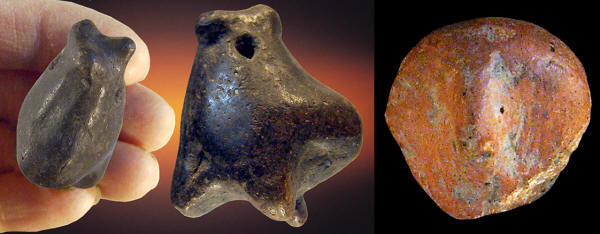
OWL EFFIGIES MADE FROM
CLAY
CAHOKIA MOUNDS SITE
MADISON & ST. CLAIR COUNTIES, ILLINOIS
Both of these clay owl effigies were found on the Cahokia Mounds site in
southern Illinois. The example on the right has no eyes but the round
shape of the head and the beak are features that make the figure
appear to look like an owl. The lower portion of the head is broken
away indicating that it was probably once attached to some type of
ceramic vessel.
The clay effigy on the left was found at Mound 19 on the
Cahokia Mounds site. It represents a stylized version of a full
figured standing owl. It's main design features are the "horns,"
beak, tail, legs, extended front, and side to side perforation. The
perforation indicates it was probably worn as a pendant. Although
the form seems odd, it does represent a design type that has been
reported from sites farther to the east. It measures approximately 1 3/4 inches
(4.5 cm) long. |
|
|
Many areas of the world associate the owl
with the moon and the moon with the feminine. In fact, the Latin
word for owl is stix, which also means wise woman and witch. The moon
association may
be why owls are so often associated with goddesses, female spirits, wise
women, midwives, and witches. As an example, Lakshmi, the Hindu Goddess
of wealth, prosperity, fortune, and the embodiment of beauty, uses an
owl as her vehicle. |
|
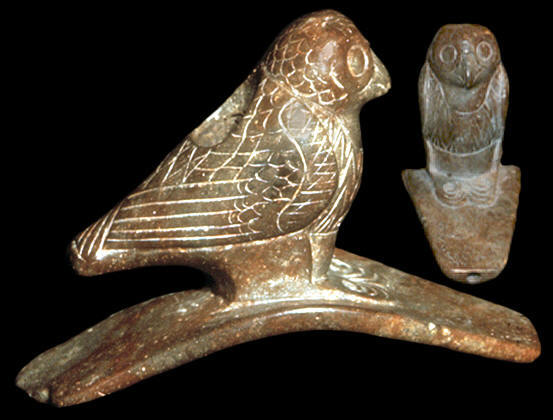
PHOTO BY BILL FECHT and DENNIS VESPER----CLEM CALDWELL COLLECTION
OWL EFFIGY PLATFORM PIPE
KNIGHT SITE
MIDDLE WOODLAND HOPEWELL CULTURE
CALHOUN COUNTY, ILLINOIS
This picture shows an exceptionally nice example of an effigy
platform pipe that was found on the Knight site in southern
Illinois. It skillfully illustrates the full image of a standing
owl. The carving of the feet, claws, feathers and features of the head
are all very well done. This pipe was once in the Dr. Titterington
collection and is known as the "Titterington pipe."
Hopewell craftsmen are known for their finely crafted animal
effigy platform pipes. Some of the best examples were found in 1915,
during excavation of Tremper Mound in Scioto County, Ohio.
The Tremper Mound pipes include sculptured images of owls, hawks,
ducks, cranes, quail, prairie chicken, crow, toads, turtles, beaver,
otter, mink, raccoon, rabbit, squirrel, porcupine, possum, fox,
wolf, bobcat, bear, mountain lion, dog and deer. |
|
|
In a complex way, the nocturnal owl is connected
with the moon and the idea of a "different way of knowing or being." It
has to do with the idea of the reflected light of the moon as compared
to the direct light of the sun. In-other-words, the reflected light of
the moon may be interpreted as indirect knowledge. This "indirect way of
knowing concept" is why owls may be connected so often to seers,
shamans, or even second sight (perceiving
things that are not present to the senses). |
|
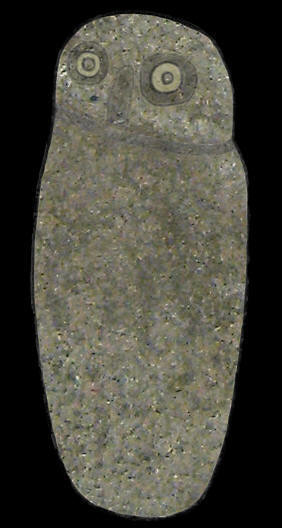
COMPUTERIZED LIKENESS OF ORIGINAL PIPE
"ARTIFACTS," Vol. 7, ISSUE No. 1, 1976
OWL EFFIGY PIPE
HARDIN VILLAGE SITE
GREENUP, KENTUCKY
This computerized
image shows the basic design pattern of an owl effigy pipe that was
found on a site in northeastern Kentucky. The bowl is located behind
the neck area. It's made from a very fine green-gray Ohio pipestone
and measures approximately 2 1/2 inches (6.4 cm) long. |
|
|
In Mesoamerica the owl is connected to the underworld and the
abode of the dead but also to a warrior class. At Teotihuacán (central
Mexico), owls are depicted on stone
sculpture and ceramics as wearing weapons and shields. The Peruvian
Moche culture also depicts the owl as a warrior. Costa Rican owl maces
are believed to have once belonged to members of a warrior caste of wealthy
individuals. |
|
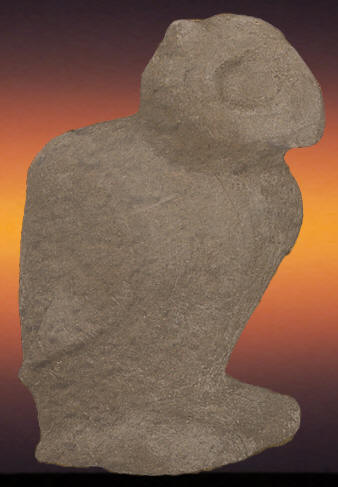
COMPUTERIZED LIKENESS OF ORIGINAL PIPE,
JOURNAL OF THE ILLINOIS STATE ARCHAEOLOGICAL SOCIETY, VOL. 7, NO. 2,
1949
OWL EFFIGY PIPE
ILLINOIS
This pipe was originally in the Claude Stone
collection. It's illustrated in an early issue of the Journal Of The
Illinois State Archaeological Society over a caption saying it's
"described in another issue." It's a good example of a stone carved
owl effigy pipe, complete with the large eyes and "horns" to
identify it as a great horned owl. |
|
|
In South American, the owl is mentioned in
different myths, both in a positive and negative way. The Chamacoco, of
southern Brazil and Paraguay, are said to have received fire from the
"culture hero" who is in the form of a hawk who in turn received it
directly from the owl. In the southern area of South America, known as
the Gran Chaco, in Bolivia, Paraguay and northern Argentina, the owl is
reported by some people as a harbinger of ill tidings who says, "Beware!
I am bringing spirits to harm you." The Yahgan of southern Chile are
also reported to believe the call of the owl could mean a murder or
someone may die. On-the-other-hand, the Aymara of the Andes Mountains of
Bolivia, Peru, and Chile describe a curative effect for earache by
burning owl feathers. The Chebero, of the upper Amazon River, believed
that medicine men were trained by an owl. |
|
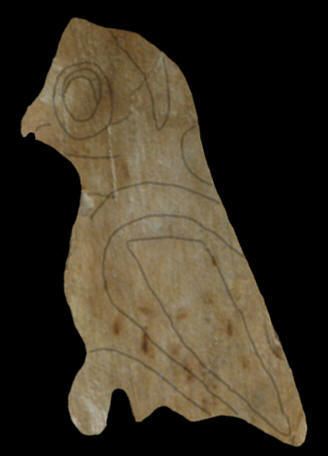
COMPUTERIZED LIKENESS OF ORIGINAL BONE CARVING,
BULLETIN OF THE ARKANSAS ARCHAEOLOGICAL SOCIETY, VOL. 16, 17, 18
BONE CARVED OWL EFFIGY
CAMPBELL SITE
PEMISCOT COUNTY, MISSOURI
This picture illustrates a
drawing and computerized likeness of a carved bone owl effigy that was
found with a burial on the Campbell site in southeastern Missouri.
It's described as a, "remarkably well-preserved carved bone owl
effigy pendant that was recovered in association with a child." It was
positioned at the neck of the individual and most probably was used as a
pendant. The bone is drilled at the neck from front to back and it has
nicely carved feet. It was carved from the second phalanx (toe bone) of
an adult deer and measures 1 5/8 inches (4.2 cm) long.
Other examples of bone carved owls have been reported from
Arkansas & Tennessee. A bone carved bird effigy from Arkansas is described as,
"reminiscent of an owl." It was found in a mound in Lafayette
County. Another example is reported from a Middle Mississippian
village site near Memphis, Tennessee and described as a pendant that was
carved from a deer phalange to resemble an owl." Two other owl bone
pendants are reported from separate sites. One example was found on the
little Harpeth River in Williamson County, Tennessee and the other is a
second bone owl found on the Campbell site in Scott County, Missouri.
The Harpeth River bone owl is reported to have been found in associated
with a child burial. |
|
|
It's also interesting
to note that the owl is not regarded as anything positive in biblical
texts. There is a warning not to eat the owl and that it's also dreadful
to hear. For example, in Isaiah, a bad place is described as, "But wild
beasts of the desert shall lie there; and their houses shall be full of
doleful creatures; and owls shall dwell there, and satyrs shall dance
there. Or a quote from the book of Job says, "I
am a brother to dragons, and a companion to owls." Buddhist and Hindu
tradition also regard owls as demonic and unlucky. |
|
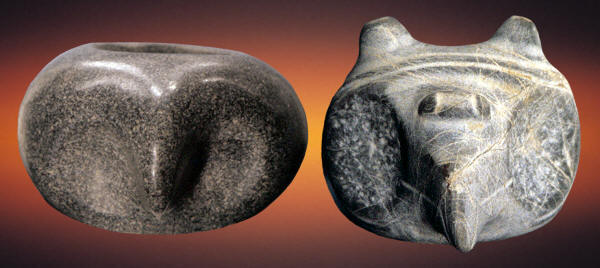
OWL MACE HEADS
COSTA RICA, CENTRAL AMERICA
est. A.D. 300 TO 1550
This
picture shows two common forms of Costa Rican owl effigy mace heads.
Costa Rican stone maces are unique for their many different carved
forms that illustrate both the natural and metaphysical world. Some
of the images are represented in highly stylized forms. Costa Rican
maces are typically found in tombs with wealthy individuals, rather
than in utilitarian contexts. Costa Rican maces were considered important and valued items within the
culture.
In Mesoamerica the owl is connected to the underworld and the
abode of the dead but also to a warrior class. At Teotihuacán (central
Mexico), owls are depicted on stone
sculpture and ceramics as wearing weapons and shields. The Peruvian
Moche culture also depicts the owl as a warrior. These Costa Rican
owl maces may have once belonged to members of a warrior caste of
wealthy individuals. Both of these maces were found on sites in the
central highland of Costa Rica. The example at left appears to be made of a granite-like stone and
it measures 2 inches (5.1 cm) high. |
|
|
It's remarkable how the human mind has taken such a
majestic animal as an owl and developed so many stories, myths,
fables and folk tales. The owl has been used as a symbol of blame or
praise for a long time by people trying to make sense of a mysterious world.
The dreadful stories do seem to outweigh all the positive ones. Maybe
rightly so, because the owl does have ghostly issues. If you've ever had
one fly past your head on a dark night, it's silent, unexpected and
startling, so ghost may be your first thought, until your mind settles
for owl and life is good again. |
|
"REFERENCES"
1896, Boas, Franz, "Sixth Report On
The Indians Of British Columbia, In Report Of The 61st Meeting Of The
British Association For The Advancement Of Science, 1891."
1903, Powell, J. W., Twentieth Annual Report Of The Bureau Of
American Ethnology To The Secretary Of The Smithsonian Institution,
1898-1899."
1946, Cooper, John M., "The Yahgan," Handbook Of South American Indians,
Vol. 1, The Marginal Tribes (Smithsonian).
1946, Tschopik, Jr., Harry, "The Aymara," Handbook Of South American Indians,
Vol. 2, The Andean Civilizations (Smithsonian).
1949, Stone, Claude, "Journal of the Illinois State Archaeological
Society, Vol. 7, No. 2."
1949, Metraux, Alfred, "Religion And Shamanism," Handbook Of South American Indians,
Vol. 5, The Comparative Ethnology Of South American Indians (Smithsonian).
1961, Devereux, George, "Mohave Ethnopsychiatry And Suicide: The
Psychiatric Knowledge And The Psychic Disturbances Of An Indian Tribe,"
Bureau Of American Ethnology Bulletin 175 (Smithsonian).
1967, Medlin, Faith, "Centuries Of Owls, In Art And The Written
Word."
1976, ?, "Artifacts, Vol. 6, Issue No., 1," p. 12.
1977, Klinger, Timothy C.,, "An Exceptional Example Of Carved Bone
Technology From The Lower Mississippi Valley," The Arkansas
Archaeologist, Bulletin Of The Arkansas Archaeologist Society, Vol. 16,
17, 18, 1975-76-77, pp. 93-98.
1984, Erdoes, Richard, Ortiz, Alfonso, "American Indian Myths And
Legends."
1994, (edited by) Mills, Antonia & Slobodin, Richard, "Amerindian
Rebirth: Reincarnation Belief Among North American Indians And Inuit."
2001, Gibson, Jon L., "The Ancient Mounds Of Poverty Point."
2006, Werness, Hope B., "The Continuum, Encyclopedia Of Animal
Symbolism In Art."
2008, Wheye, Darryl & Kennedy, Donald, "Humans, Nature, And
Birds, Science Art From Cave Walls To Computer Screens."
Personal Communication with, Mike Gramly.
|
|
RECENT
LISTINGS HOME
ORDERING |